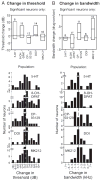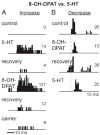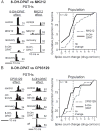Different serotonin receptor agonists have distinct effects on sound-evoked responses in inferior colliculus
- PMID: 16870843
- PMCID: PMC2579767
- DOI: 10.1152/jn.00046.2006
Different serotonin receptor agonists have distinct effects on sound-evoked responses in inferior colliculus
Abstract
The neuromodulator serotonin has a complex set of effects on the auditory responses of neurons within the inferior colliculus (IC), a midbrain auditory nucleus that integrates a wide range of inputs from auditory and nonauditory sources. To determine whether activation of different types of serotonin receptors is a source of the variability in serotonergic effects, four selective agonists of serotonin receptors in the serotonin (5-HT) 1 and 5-HT2 families were iontophoretically applied to IC neurons, which were monitored for changes in their responses to auditory stimuli. Different agonists had different effects on neural responses. The 5-HT1A agonist had mixed facilitatory and depressive effects, whereas 5-HT1B and 5-HT2C agonists were both largely facilitatory. Different agonists changed threshold and frequency tuning in ways that reflected their effects on spike count. When pairs of agonists were applied sequentially to the same neurons, selective agonists sometimes affected neurons in ways that were similar to serotonin, but not to other selective agonists tested. Different agonists also differentially affected groups of neurons classified by the shapes of their frequency-tuning curves, with serotonin and the 5-HT1 receptors affecting proportionally more non-V-type neurons relative to the other agonists tested. In all, evidence suggests that the diversity of serotonin receptor subtypes in the IC is likely to account for at least some of the variability of the effects of serotonin and that receptor subtypes fulfill specialized roles in auditory processing.
Figures









Similar articles
-
Activation of the serotonin 1A receptor alters the temporal characteristics of auditory responses in the inferior colliculus.Brain Res. 2007 Nov 21;1181:21-9. doi: 10.1016/j.brainres.2007.08.053. Epub 2007 Sep 4. Brain Res. 2007. PMID: 17916336 Free PMC article.
-
5-HT1A and 5-HT1B receptors differentially modulate rate and timing of auditory responses in the mouse inferior colliculus.Eur J Neurosci. 2010 Aug;32(3):368-79. doi: 10.1111/j.1460-9568.2010.07299.x. Epub 2010 Jul 14. Eur J Neurosci. 2010. PMID: 20646059 Free PMC article.
-
Serotonin 1B receptor modulates frequency response curves and spectral integration in the inferior colliculus by reducing GABAergic inhibition.J Neurophysiol. 2008 Sep;100(3):1656-67. doi: 10.1152/jn.90536.2008. Epub 2008 Jul 16. J Neurophysiol. 2008. PMID: 18632894 Free PMC article.
-
Serotonin in the inferior colliculus.Hear Res. 2002 Jun;168(1-2):1-11. doi: 10.1016/s0378-5955(02)00365-9. Hear Res. 2002. PMID: 12117504 Review.
-
Context-dependent modulation of auditory processing by serotonin.Hear Res. 2011 Sep;279(1-2):74-84. doi: 10.1016/j.heares.2010.12.015. Epub 2010 Dec 25. Hear Res. 2011. PMID: 21187135 Free PMC article. Review.
Cited by
-
Listening to your partner: serotonin increases male responsiveness to female vocal signals in mice.Front Hum Neurosci. 2024 Jan 24;17:1304653. doi: 10.3389/fnhum.2023.1304653. eCollection 2023. Front Hum Neurosci. 2024. PMID: 38328678 Free PMC article.
-
Acoustic trauma triggers upregulation of serotonin receptor genes.Hear Res. 2014 Sep;315:40-8. doi: 10.1016/j.heares.2014.06.004. Epub 2014 Jul 2. Hear Res. 2014. PMID: 24997228 Free PMC article.
-
Inhibition of SK and M channel-mediated currents by 5-HT enables parallel processing by bursts and isolated spikes.J Neurophysiol. 2011 Mar;105(3):1276-94. doi: 10.1152/jn.00792.2010. Epub 2011 Jan 5. J Neurophysiol. 2011. PMID: 21209357 Free PMC article.
-
The dominant role of inhibition in creating response selectivities for communication calls in the brainstem auditory system.Hear Res. 2013 Nov;305:86-101. doi: 10.1016/j.heares.2013.03.001. Epub 2013 Mar 29. Hear Res. 2013. PMID: 23545427 Free PMC article. Review.
-
Serotonin in the inferior colliculus fluctuates with behavioral state and environmental stimuli.J Exp Biol. 2010 Apr;213(Pt 7):1009-17. doi: 10.1242/jeb.035956. J Exp Biol. 2010. PMID: 20228336 Free PMC article.
References
-
- Bacon WL, Beck SG. 5-Hydroxytryptamine(7) receptor activation decreases slow afterhyperpolarization amplitude in CA3 hippocampal pyramidal cells. J Pharmacol Exp Ther. 2000;294:672–679. - PubMed
-
- Barnes N, Sharp T. A review of central 5-HT receptors and their function. Neuropharmacology. 1999;38:1083–1152. - PubMed
-
- Bergqvist P, Dong J, Blier P. Effect of atypical antipsychotic drugs on 5-HT2 receptors in the rat orbito-frontal cortex: an in vivo electrophysiological study. Psychopharmacology (Berl) 1999;143:89–96. - PubMed
-
- Brandão M, Melo L, Cardoso S. Mechanisms of defense in the inferior colliculus. Behav Brain Res. 1993;58:49–55. - PubMed
Publication types
MeSH terms
Substances
Grants and funding
LinkOut - more resources
Full Text Sources

